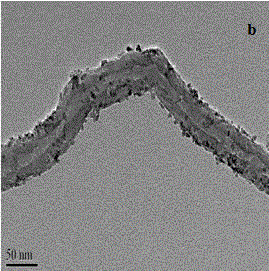Method for adsorbing and removing phosphates from water body by using zirconium oxide modified carbon nano tubes
A technology of carbon nanotubes and phosphate, which is applied in the field of removing phosphate in water and adsorption method to remove phosphate in water, achieving good economic and environmental benefits, remarkable effect, and mild adsorption treatment conditions
- Summary
- Abstract
- Description
- Claims
- Application Information
AI Technical Summary
Problems solved by technology
Method used
Image
Examples
Embodiment 1
[0023] Put 5.0 g of carbon nanotubes in a muffle furnace and burn at 300-350 °C for 1-1.5 h to remove amorphous carbon and graphite fragments attached to the surface of carbon nanotubes; after cooling to room temperature, add to 250 mL of 70 wt. % sodium hypochlorite solution, ultrasonically dispersed for 0.5-1 h, reflux reaction in a constant temperature water bath at 85 °C for 4-6 h to remove metal impurities contained in the carbon nanotubes, and finally washed to neutrality and vacuum-dried. Weigh 1.0 g of purified carbon nanotubes in a certain volume of 65.0-68.0% concentrated nitric acid solution, ultrasonically disperse for 0.5-1 h, then reflux in an oil bath at 110-140 °C for 8-12 h, wash with water and dry.
[0024] Disperse 100 mg of pretreated carbon nanotubes (denoted as MWNT-0) to 80 mL of a certain concentration (2 mmol L -1 , 4 mmol·L -1 , 10 mmol·L -1 ) in an aqueous solution of zirconium oxychloride, ultrasonically dispersed for 0.5-1 h, hydrothermally react...
Embodiment 2
[0027] The zirconia-modified carbon nanotube MWNT-Zr-10 (weighted average particle size: 4.91 nm) synthesized in Example 1 was used as an adsorbent to treat phosphate-containing water. Static adsorption was carried out in a 40 mL EPA bottle with tetrafluoroethylene gasket, the mass ratio of adsorbent to phosphate-containing water was 1:2000, pH=6.0±0.2, and the initial concentration of phosphate was 64.5 mg L -1 , the water does not contain NaCl and other coexisting anions, the adsorption temperature is 25°C, and the adsorption time is 24 h. After adsorption equilibrium, filter through a 45 μL aqueous filter head, and the phosphate concentration in the filtrate is measured at 700 nm by molybdenum blue colorimetry. The measured adsorption amount of phosphate (calculated as phosphorus, the same below) is 17.60 mg·g-1 , the adsorption capacity of phosphate after standardization by zirconia is 38.60 mg·g -1 ZrO 2 .
Embodiment 3
[0029] The operating conditions for adsorption removal are the same as in Example 2, the adsorbent is MWNT-Zr-4, its weighted average particle size is 3.74nm, and the phosphate adsorption capacity is 13.84 mg g -1 , the adsorption capacity of phosphate after standardization by zirconia is 54.06 mg·g -1 ZrO 2 .
PUM
| Property | Measurement | Unit |
|---|---|---|
| adsorption capacity | aaaaa | aaaaa |
| adsorption capacity | aaaaa | aaaaa |
| adsorption capacity | aaaaa | aaaaa |
Abstract
Description
Claims
Application Information
 Login to View More
Login to View More - R&D
- Intellectual Property
- Life Sciences
- Materials
- Tech Scout
- Unparalleled Data Quality
- Higher Quality Content
- 60% Fewer Hallucinations
Browse by: Latest US Patents, China's latest patents, Technical Efficacy Thesaurus, Application Domain, Technology Topic, Popular Technical Reports.
© 2025 PatSnap. All rights reserved.Legal|Privacy policy|Modern Slavery Act Transparency Statement|Sitemap|About US| Contact US: help@patsnap.com



